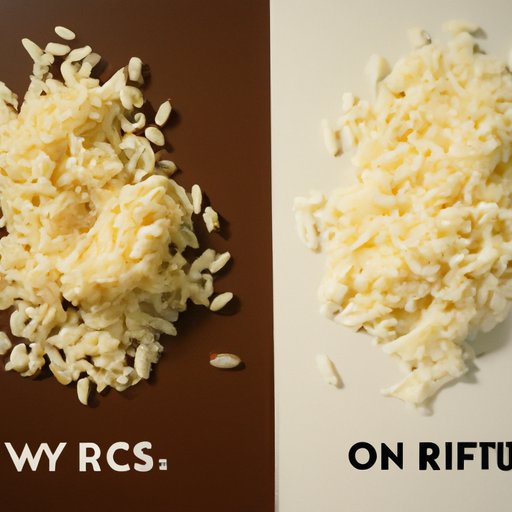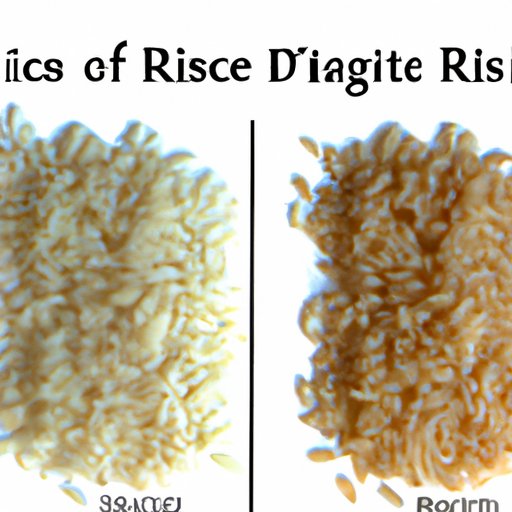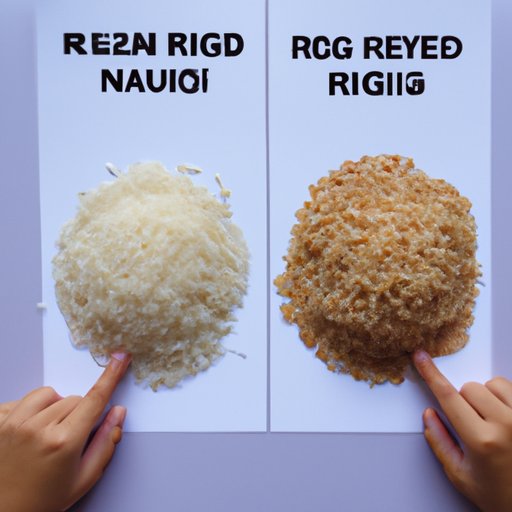Introduction
Rice is one of the most widely consumed grains in the world, with an estimated 3.5 billion people consuming it as a staple food. It is an important source of energy and nutrients for many cultures, and it has been part of the human diet for centuries. There are two main types of rice – white and brown – and both have their own unique nutritional profile. But which type is healthier? This article will explore the nutritional benefits of white and brown rice, as well as their impact on health.
A Comparison of the Nutritional Benefits of White and Brown Rice
White rice and brown rice differ in terms of the amount of vitamins and minerals they contain. White rice is usually enriched with iron, thiamin, niacin, and other vitamins and minerals that are lost during milling. Brown rice, on the other hand, is more nutrient-dense, containing more fiber, B-vitamins, magnesium, phosphorus, and other essential nutrients than white rice. The two types of rice also differ in terms of macronutrients and glycemic index.
Vitamins and Minerals
White rice is often enriched with iron, thiamin, niacin, and other vitamins and minerals that are lost during milling. These nutrients are added back into the grain to make up for the losses incurred during the milling process. Brown rice, however, contains more natural vitamins and minerals than white rice. It is a good source of B-vitamins, magnesium, phosphorus, zinc, and other essential nutrients.
Macronutrients
White rice is mostly composed of carbohydrates, with a small amount of protein and fat. Brown rice, on the other hand, contains more protein and fat than white rice. It also contains more dietary fiber, which can help promote digestive health and reduce the risk of certain diseases.
Glycemic Index
The glycemic index (GI) is a measure of how quickly a food increases blood sugar levels. White rice has a higher GI than brown rice, meaning it can cause a rapid rise in blood sugar levels after consumption. Brown rice, on the other hand, has a lower GI, which means it has a slower and more gradual effect on blood sugar levels.

Exploring the Pros and Cons of Eating White and Brown Rice
Both white and brown rice have their advantages and disadvantages when it comes to nutrition and health. While white rice is generally easier to cook and may be more palatable to some people, it lacks some of the beneficial nutrients found in brown rice. On the other hand, brown rice may take longer to cook and may not be as appealing to some people, but it contains more vitamins and minerals than white rice.
Advantages and Disadvantages of White Rice
White rice is generally easier to cook and may be more palatable to some people. It is also high in carbohydrates, making it a good source of energy. However, white rice is often stripped of its bran and germ during processing, which removes some of its beneficial nutrients. It is also high in glycemic index, meaning it can cause a rapid rise in blood sugar levels.
Advantages and Disadvantages of Brown Rice
Brown rice is more nutritious than white rice, as it contains more vitamins and minerals. It is also low in glycemic index, making it less likely to cause a rapid rise in blood sugar levels. However, brown rice may take longer to cook and may not be as appealing to some people. It is also higher in calories than white rice.

An Examination of the Health Impacts of Eating White Versus Brown Rice
Eating white or brown rice can have different effects on health. Here, we will explore the health impacts of eating white versus brown rice.
Effects on Blood Sugar Levels
White rice has a higher glycemic index than brown rice, meaning it can cause a rapid rise in blood sugar levels after consumption. This can be problematic for people with diabetes, as it can lead to dangerous spikes in blood sugar levels. Brown rice, on the other hand, has a lower glycemic index, meaning it has a slower and more gradual effect on blood sugar levels.
Impact on Heart Health
White rice is low in fiber, which is important for maintaining a healthy heart. Brown rice is a good source of fiber, which can help reduce cholesterol levels and protect against heart disease. It is also a good source of magnesium, which can help maintain healthy blood pressure levels.
Effect on Weight Loss
White rice is high in calories, so it is not recommended for weight loss. Brown rice is lower in calories than white rice, making it a better choice for those looking to lose weight. Brown rice is also high in fiber, which can help you feel fuller for longer and reduce your calorie intake.
Understanding the Differences Between White and Brown Rice in Relation to Health
White and brown rice differ in terms of their processing methods, calorie content, and composition of refined and unrefined grains. Here, we will examine these differences in relation to health.
Refined Versus Unrefined Grains
White rice is a refined grain, meaning it has been milled and processed to remove the bran and germ. This removes some of the beneficial vitamins and minerals found in the grain. Brown rice, on the other hand, is an unrefined grain, meaning it retains the bran and germ, and thus more of the beneficial vitamins and minerals.
Processing Methods
White rice is usually polished and milled, which removes the bran and germ and strips away some of its beneficial nutrients. Brown rice is minimally processed, meaning it retains more of its natural vitamins and minerals. This makes it a better source of essential nutrients than white rice.
Calorie Content
White rice is higher in calories than brown rice. A 1-cup serving of cooked white rice contains approximately 206 calories, whereas a 1-cup serving of cooked brown rice contains approximately 216 calories. Therefore, if you’re looking to cut down on calories, brown rice is a better choice than white rice.

Comparing the Glycemic Index of White and Brown Rice
The glycemic index (GI) is a measure of how quickly a food increases blood sugar levels. White rice has a higher GI than brown rice, meaning it can cause a rapid rise in blood sugar levels after consumption. According to a study published in the American Journal of Clinical Nutrition, white rice has a GI of 73, while brown rice has a GI of 55.
Impact of GI on Blood Glucose Levels
Foods with a high GI can cause a rapid spike in blood sugar levels, which can be problematic for people with diabetes. Foods with a low GI, such as brown rice, have a slower and more gradual effect on blood sugar levels.
GI Ranking of White and Brown Rice
White rice has a higher GI than brown rice, meaning it can cause a rapid rise in blood sugar levels after consumption. According to the American Journal of Clinical Nutrition, white rice has a GI of 73, while brown rice has a GI of 55. Therefore, brown rice is a better choice for those looking to manage their blood sugar levels.
Evaluating the Macronutrient Content of White and Brown Rice
White and brown rice differ in terms of their macronutrients. Here, we will evaluate the macronutrient content of white and brown rice.
Carbohydrate Content
White rice is mostly composed of carbohydrates, with a small amount of protein and fat. A 1-cup serving of cooked white rice contains approximately 45 grams of carbohydrates. Brown rice is also high in carbohydrates, with a 1-cup serving containing approximately 52 grams of carbohydrates.
Protein Content
White rice is low in protein, with a 1-cup serving containing only 4 grams of protein. Brown rice is higher in protein, with a 1-cup serving containing approximately 5 grams of protein. Therefore, if you’re looking to increase your protein intake, brown rice is a better choice than white rice.
Fat Content
White rice is low in fat, with a 1-cup serving containing only 0.4 grams of fat. Brown rice is slightly higher in fat, with a 1-cup serving containing approximately 1.8 grams of fat. Therefore, if you’re looking to increase your fat intake, brown rice is a better choice than white rice.
Conclusion
White and brown rice differ in terms of their nutritional profile and health impacts. White rice is generally easier to cook and may be more palatable to some people, but it has a higher glycemic index and is stripped of its bran and germ during processing, which removes some of its beneficial nutrients. Brown rice is more nutritious than white rice, as it contains more vitamins and minerals, is lower in glycemic index, and is a good source of fiber. It may take longer to cook and may not be as appealing to some people, but it is lower in calories than white rice. Ultimately, it is up to you to decide which type of rice is best for you and your health.
In conclusion, both white and brown rice have their advantages and disadvantages when it comes to nutrition and health. While white rice is generally easier to cook and may be more palatable to some people, it lacks some of the beneficial nutrients found in brown rice. On the other hand, brown rice may take longer to cook and may not be as appealing to some people, but it contains more vitamins and minerals than white rice. Ultimately, it is up to you to decide which type of rice is best for you and your health.
(Note: Is this article not meeting your expectations? Do you have knowledge or insights to share? Unlock new opportunities and expand your reach by joining our authors team. Click Registration to join us and share your expertise with our readers.)
